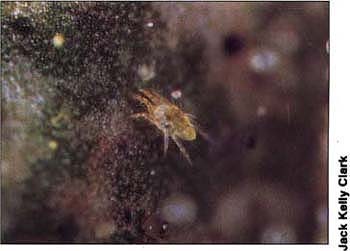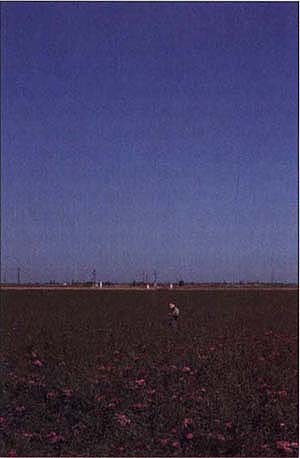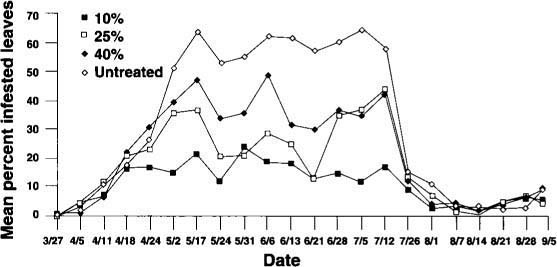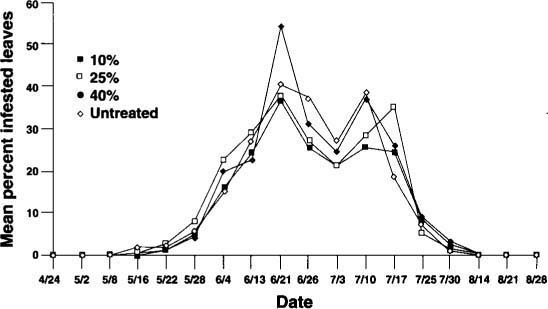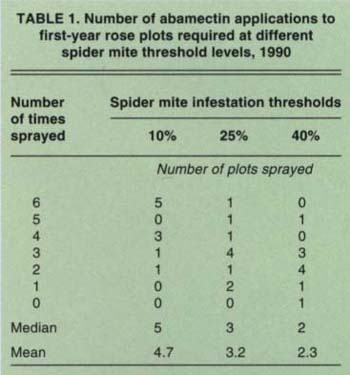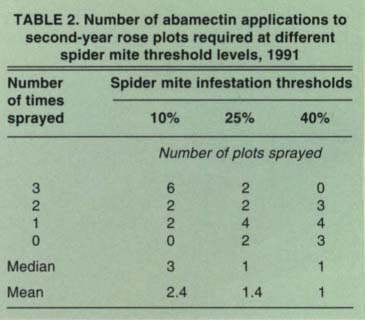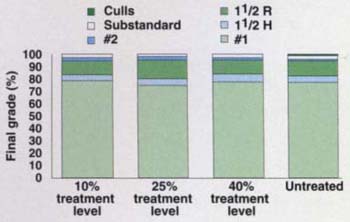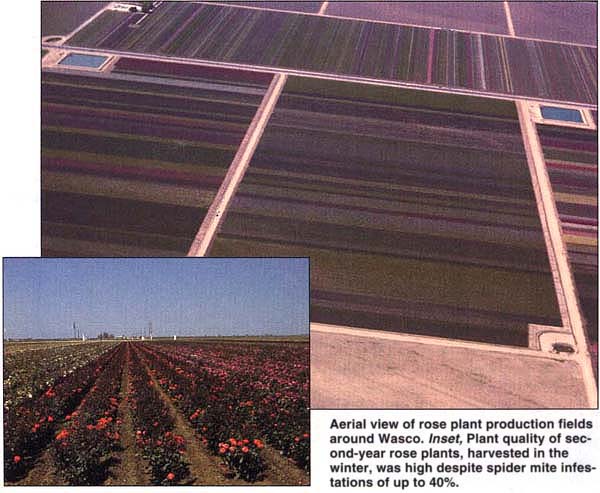All Issues
Improved mite sampling may reduce acaricide use in roses
Publication Information
California Agriculture 49(3):38-40. https://doi.org/10.3733/ca.v049n03p38
Published May 01, 1995
PDF | Citation | Permissions
Abstract
Spider mites are considered to be the most important invertebrate pests of commercial field-grown rose plants, but sampling methods and treatment thresholds have been subjective. This study shows that roses exhibit a higher tolerance for spider mites than previously thought. Quality rose plants were produced with fewer acaricide treatmentsby using a rapid presence/absence field sampling method and treatment thresholds for spider mites.
Full text
Kern County produces the majority of U.S. rose plants, harvesting about 2,000 acres of rose plants annually in the Wasco area. Most of these are cultivars destined for use as outdoor plants and most are grown on a 2-year production cycle.
Rootstock cuttings are planted in the field in December or January, then budded with scion varieties from March through early June. Early in the second year, the plants are cut back to the bud union to force the scion bud. Canes (branches) of the scion variety grow through the summer, then the plants are dug, graded and shipped beginning in November.
Wholesale prices reach as high as $2.50 per plant for some varieties. There are typically 24,000 plants per acre, so each field represents a sub-stantial investment.
Rose growers in the southern San Joaquin Valley consider several species of spider mites to be their most troublesome invertebrate pests. These mites cause loss of leaf chlorophyll and, presumably, loss of plant vigor.
High mite populations on second-year plants can cause defoliation, resulting in sunburn that renders the plants unfit for market. First-year plants appear more tolerant of spider mites.
In the past, growers controlled mites by treating rose fields with acaricide four to eight times per season, with as many as 13 applications in some years to prevent damage to the high-value crop. However, no published studies address sampling methods, mite thresholds, or the impact of spider mite populations on the final grade and yield of rose plants.
The value of the crop and perceived need to differentiate the product from competitors make pesticide applications seem relatively inexpensive, but frequent use of acaricides may create problems. Repeated applications are suspected of selecting for resistant spider mite populations; in other words, changing the spider mite population so that the hardier mites predominate, which can make them difficult to control in other crops. Worker safety and environmental concerns also argue for reducing acaricide applications when possible. The number of acaricides on the market also has dropped substantially, providing further incentive for examining alternative treatment methods.
The 1990–1991 study
In previous work, we found that using a sampling technique known as presence / absence (PA)was useful in assessing spider mite populations in rose fields. The PA technique is rapid, gives quantitative data, and data are correlated to mite counts obtained by brushing.
To evaluate the effects of different mite population levels on rose plant growth and yield, we began a field study in 1990. We set treatment thresholds of 40% infested for first-year plants and 25% for second-year plants. Two rows of 'Dr. Huey' root-stock were planted in January according to customary industry practice. Plants were then budded to the 'Peace' variety later in the spring. Two guard rows buffered the plants to the west, with numerous other rows acting as buffers to the east. Randomized plots were divided into two 25-foot rows. We sampled the center 20 feet of each plot weekly, selecting 10 leaves from 10 rose plants in each row for a total of 20 leaves per plot. These leaves were noted for PA of spider mites. The species present were predominately Pacific mite (Tetranychus pacificus) with some strawberry mite (T. turkestani).
We assigned four PA treatment thresholds — 10%, 25%, 40% and untreated — to plots at random. All were replicated 10 times. When a plot exceeded its PA threshold for two consecutive weeks, it was treated by back-pack sprayer with abamectin (Avid 0.15 EC) at a rate of 4.0 oz/acre (formulated product) in the equivalent of 50 gpa water, with no surfactant added. The plots remained in place for both years of the growing cycle. Abamectin was chosen because of its efficacy, selectivity, low phytotoxicity to roses and current utilization in rose production in the Wasco area.
During 1990 it was possible to hold spider mite levels to 25% or 40%. However, despite repeated acaricide applications, it was not possible to maintain a mean 10% level across plots assigned this treatment threshold (fig. 1). Since we only treated plots with mite densities exceeding 10%, there were plots over 10% on most dates. It could be interpreted that background mite populations exceeded 10% PA at frequent intervals. As would be expected, more frequent acaricide applications were required to hold spider mites at respectively lower levels (table 1). Untreated plots never reached 100% infestation and did not defoliate.
In 1991, spider mite populations in second-year roses followed approximately the same course (fig. 2). Again, acaricides were used more frequently on plots with lower thresholds to bring the population down to the desired level (table 2). Untreated plots in the second year did not show evidence of extreme mite pressure leading to defoliation.
Yield results were measured beginning September 1991, when a stand count was taken. We found no significant difference among the plots, thus indicating that higher treatment thresholds had not affected overall plant survival.
In December, plants were mechanically defoliated and mowed preparatory to harvest in early January. The middle 15 plants from each row of the plot were weighed, and graded according to industry standards. Rose plants are graded according to the number and size of canes above the bud union. A larger number and size of canes are required for a higher grade. Grading was done using measurements of cane length and caliper rather than by eye alone. We found no significant difference among plant weights or grade. Plants were uniformly large with a mean weight of more than 3/4 pound per plant for each treatment. Plant quality as measured by grade was also uniformly high with 74% or more of plants considered grade one, despite treatment procedures (fig. 3). Therefore, spider mite population did not adversely affect plant size or quality of any of the plants observed in this study.
Conclusion
This study shows that roses can tolerate relatively high spider mite densities without loss in yield or quality. The use of thresholds in a PA approach provides a quantitative frame-work for treatment and precludes in-discriminate use of acaricides, but requires regular monitoring for spidermites. Also, during the course of monitoring, especially in the first year, we often noticed mite predators such as western flower thrips, minute pirate bug and predatory mites in the field. These insects probably were able to thrive and aid in spider mite control because of few insecticide or acaricide applications to the surrounding mother block, and none to the guard rows.
TABLE 1. Number of abamectin applications to first-year rose plots required at different spider mite threshold levels, 1990
TABLE 2. Number of abamectin applications ot second-year rose plots required at different spider mite threshold levels, 1991
Fig. 3. Final grade of 'Peace' roses treated at different PA thresholds for spider mites. There was no difference among treatments within any of the grade.
Aerial view of rose plant production fields around Wasco. Inset, Plant quality of second-year rose plants, harvested in the winter, was high despite spider mite infestations of up to 40%.
Most rose growers, at some time, have had problems controlling spider mites in at least some portion of a field. Memories of a yield loss remain vivid and may cause an individual to be reluctant to allow spider mites to reach a moderate level, but the availability of a highly effective acaricide should give growers more confidence in achieving control when treating at a higher threshold.
Although spider mite infestation can appear damaging, crop modeling work in greenhouse roses indicates that leaves of intermediate age in the crop canopy contribute the majority of photosynthesis. Field observation suggests the same may be true of field roses, where vigorous plants, especially the first-year rootstock, appear able to outgrow the effects of spider mites and other antagonists. Although senescing leaves are normally present at the base of the canopy, new leaves are formed fast enough to compensate for plant damage.
This study suggests that fewer acaricide applications than previously thought may be sufficient to preserve rose plant quality. This can provide an economic benefit to growers because one acaricide application costs from $40 to $60 per acre. The results are also encouraging from the standpoint of worker safety, environmental protection, and maintenance of acaricide efficacy. Only three acaricides are presently registered, which argues for careful stewardship through rotation and minimal use.
Results of this experiment and previous sampling work were presented to growers and pest control advisors in 1991 and early 1992. Field meetings, which included hands-on training using the PA method, were also held in 1991. Most growers use the PA method at this time. Total pesticide reporting from Agricultural Commissioner data shows the mean number of acaricide applications per location in roses dropped in 1992 to 1.45. This figure represents a substantial improvement over historic frequency.



